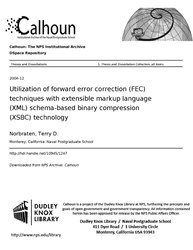File:Utilization of forward error correction (FEC) techniques with extensible markup language (XML) schema-based binary compression (XSBC) technology (IA utilizationoffor109451247).pdf

Original file (1,275 × 1,650 pixels, file size: 1.3 MB, MIME type: application/pdf, 192 pages)
| This is a file from the Wikimedia Commons. Information from its description page there is shown below. Commons is a freely licensed media file repository. You can help. |
Summary
| Utilization of forward error correction (FEC) techniques with extensible markup language (XML) schema-based binary compression (XSBC) technology
( |
||
|---|---|---|
| Author |
Norbraten, Terry D. |
|
| Title |
Utilization of forward error correction (FEC) techniques with extensible markup language (XML) schema-based binary compression (XSBC) technology |
|
| Publisher |
Monterey, California. Naval Postgraduate School |
|
| Description |
In order to plug-in current open sourced, open standard Java programming technology into the building blocks of the US Navy's ForceNet, first, stove-piped systems need to be made extensible to other pertinent applications and then a new paradigm of adopting extensible and cross-platform open technologies will begin to bridge gaps with old and new weapons systems. The battle-space picture in real time and with as much detail, or as little detail needed is now a current vital requirement. Access to this information via wireless laptop technology is here now. Transmission of data to increase the resolution of that battle-space snapshot will invariably be through noisy links. Noisy links such as found in the shallow water littoral regions of interest will be where Autonomous Underwater and Unmanned Underwater Vehicles (AUVs/UUVs) are gathering intelligence for the sea warrior in need of that intelligence. The battle-space picture built from data transmitted within these noisy and unpredictable acoustic regions demands efficiency and reliability features abstract to the user. To realize this efficiency Extensible Markup Language (XML) Schema-based Binary Compression (XSBC), in combination with Vandermode-based Forward Error Correction (FEC) erasure codes, offer the qualities of efficient streaming of plain text XML documents in a highly compressed form, and a data self-healing capability should there be loss of data during transmission in unpredictable transmission mediums. Both the XSBC and FEC libraries detailed in this thesis are open sourced Java Application Program Interfaces (APIs) that can be readily adapted for extensible, cross-platform applications that will be enhanced by these desired features to add functional capability to ForceNet for the sea warrior to access on demand, at sea and in real-time. These features will be presented in the Autonomous Underwater Vehicle (AUV) Workbench (AUVW) Java-based application that will become a valuable tool for warriors involved with Undersea Warfare (UW). Subjects: Computer simulation; XML (Document markup language); Autonomous underwater vehicle (AUV) Workbench (AUVW); Erasure codes; Extensible markup language (XML); Extensible modeling and simulation framework (XMSF); Forward error correction (FEC); Scenario authoring & visualization for advanced graphical environments (SAVAGE); XML schema based binary compression (XSBC) |
|
| Language | English | |
| Publication date | December 2004 | |
| Current location |
IA Collections: navalpostgraduateschoollibrary; fedlink |
|
| Accession number |
utilizationoffor109451247 |
|
| Source | ||
| Permission (Reusing this file) |
This publication is a work of the U.S. Government as defined in Title 17, United States Code, Section 101. As such, it is in the public domain, and under the provisions of Title 17, United States Code, Section 105, is not copyrighted in the U.S. | |
Licensing
| Public domainPublic domainfalsefalse |
This work is in the public domain in the United States because it is a work prepared by an officer or employee of the United States Government as part of that person’s official duties under the terms of Title 17, Chapter 1, Section 105 of the US Code.
Note: This only applies to original works of the Federal Government and not to the work of any individual U.S. state, territory, commonwealth, county, municipality, or any other subdivision. This template also does not apply to postage stamp designs published by the United States Postal Service since 1978. (See § 313.6(C)(1) of Compendium of U.S. Copyright Office Practices). It also does not apply to certain US coins; see The US Mint Terms of Use.
|
 | |
| This file has been identified as being free of known restrictions under copyright law, including all related and neighboring rights. | ||
https://creativecommons.org/publicdomain/mark/1.0/PDMCreative Commons Public Domain Mark 1.0falsefalse
Captions
Items portrayed in this file
depicts
application/pdf
File history
Click on a date/time to view the file as it appeared at that time.
| Date/Time | Thumbnail | Dimensions | User | Comment | |
|---|---|---|---|---|---|
| current | 21:11, 25 July 2020 |  | 1,275 × 1,650, 192 pages (1.3 MB) | Fæ | FEDLINK - United States Federal Collection utilizationoffor109451247 (User talk:Fæ/IA books#Fork8) (batch 1993-2020 #31843) |
File usage
Metadata
This file contains additional information, probably added from the digital camera or scanner used to create or digitize it.
If the file has been modified from its original state, some details may not fully reflect the modified file.
| Short title | Utilization of forward error correction (FEC) techniques with extensible markup language (XML) schema-based binary compression (XSBC) technology |
|---|---|
| Author | Norbraten, Terry D. |
| Software used | Norbraten, Terry D. |
| Conversion program | Acrobat Distiller 6.0.1 (Windows) |
| Encrypted | no |
| Page size | 612 x 792 pts (letter) |
| Version of PDF format | 1.4 |


